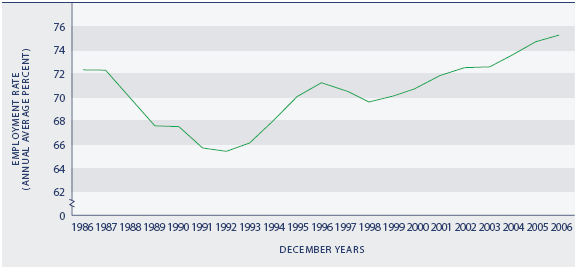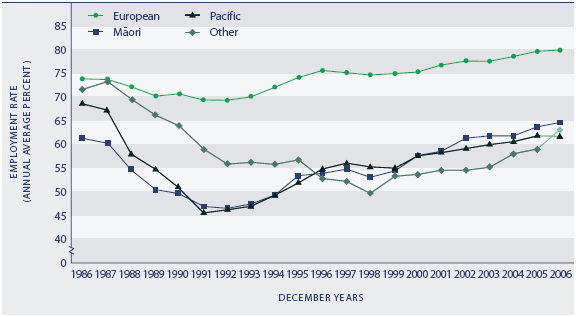Employment
Definition
The proportion of the population aged 15–64 years who are in paid employment for at least one hour per week.
Relevance
The employment rate is the best available indicator of the prevalence of paid employment. It is affected by trends in both unemployment and labour force participation (the proportion of the working-age population either employed or unemployed).
Current level and trends
In 2006, 75.2 percent of 15–64 year olds (2.057 million people) were employed. This was an increase from 74.6 percent in 2005 and higher than the rate recorded in 1986 (72.3 percent). The employment rate has been rising since 1992, except during the economic downturn in 1997 and 1998. The increase from 65.4 percent in 1992 to 75.2 percent in 2006 corresponds to a rise of 553,000 in the number of employed people aged 15–64 years. Over the same period, the number of people aged 15–64 years increased by 436,800.
The full-time employment rate for 15–64 year olds declined sharply between 1986 (60.4 percent) and 1992 (51.5 percent), and had almost recovered to the mid-1980s level by 2006 (59.4 percent). The part-time employment rate increased throughout the period, from 11.9 percent in 1986 to 15.7 percent in 2006. Although the part-time rate has almost doubled for men since 1986, women continue to have a higher part-time employment rate than men (23.5 percent compared with 7.7 percent in 2006).
Figure PW2.1 Employment rate, 1986–2006

Source: Statistics New Zealand, Household Labour Force Survey
Note: Based on population aged 15–64 years
Age and sex differences
The fall in the employment rate between 1987 and 1992 affected all age groups but was most pronounced for young people aged 15–24 years. Youth employment rates have remained relatively low during the period of employment growth since 1992, possibly due to a growth in their participation in tertiary education and training. Conversely, employment rates for people aged 45–64 years have grown strongly since 1992, driven mainly by the phasing in of the higher age of eligibility for New Zealand Superannuation, rising employment among women, and an increase in the demand for labour.
The employment rate for women is significantly lower than that for men. This is mainly because women spend more time on childcare and other unpaid household work, and are more likely than men to undertake some form of study or training. The sex gap in the employment rate is narrowing as female employment grew at a more rapid pace than male employment between 1992 and 2006.
Table PW2.1 Employment rates (%), by age and sex, selected years, 1986–2006
| Year |
15–24 |
25–44 |
45–64 |
65+ |
Males
15–64 |
Females
15–64 |
Total
15–64 |
| 1986 |
68.7 |
79.3 |
64.8 |
8.8 |
84.6 |
60.2 |
72.3 |
| 1991 |
55.0 |
74.0 |
61.5 |
6.0 |
74.0 |
57.5 |
65.7 |
| 1996 |
59.5 |
77.3 |
70.2 |
6.6 |
79.0 |
63.4 |
71.1 |
| 2001 |
55.8 |
77.9 |
73.5 |
8.6 |
79.1 |
64.8 |
71.8 |
| 2005 |
56.9 |
80.9 |
78.0 |
11.5 |
81.5 |
68.0 |
74.6 |
| 2006 |
58.8 |
80.7 |
78.7 |
12.5 |
82.1 |
68.4 |
75.2 |
Source: Statistics New Zealand, Household Labour Force Survey
Note: Average for December years
Ethnic differences
The employment rates for Māori and Pacific peoples showed the steepest fall between 1987 and 1992, but have also shown the strongest recovery since then. In 2006, the Māori employment rate, at 64.6 percent, had surpassed the 1986 level (61.2 percent). However, Pacific peoples were still less likely to be employed in 2006 (61.6 percent) than in 1986 (68.4 percent).
The European ethnic group, with the highest employment rate, has also surpassed the level of the mid-1980s (79.9 percent employed in 2006, compared with 73.8 percent in 1986). The employment rate for the Other ethnic group fell from being the second highest in the late-1980s to being the lowest over recent years. However, in 2006 their employment rate (63.2 percent) rose to be just above that of Pacific peoples.
Figure PW2.2 Employment rate, by ethnic group, 1986–2006

Source: Statistics New Zealand, Household Labour Force Survey
International comparison
In 2005, New Zealand was ranked fifth highest of 30 OECD countries with an employment rate of 74.6 percent for people aged 15–64 years. This was well above the OECD average of 65.5 percent. Iceland had the highest employment rate in 2005 (84.4 percent). The New Zealand rate in 2005 was higher than those of Sweden (73.9 percent), the United Kingdom (72.6 percent), Canada (72.5 percent), Australia (71.6 percent) and the United States (71.5 percent). New Zealand had a higher female employment rate than the United Kingdom, the United States and Australia in 2005.50
|


